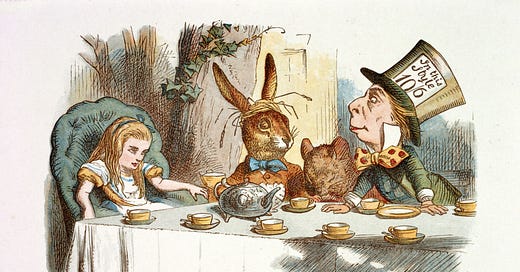I love how demonic and Wednesday Adams-like Alice looks in most of the original illustrations by Sir John Tenniel in Lewis Carroll’s classic. Or at least, a young girl possessed with dreams and a desire for more? Like Glennon Doyle’s cheetah in Untamed I’m convinced that Alice knew there was a greater world for her out there than perhaps the real one would ever dare afford her. I’m not saying Lewis Carroll was conscious of that in the writing of it but I can’t help but enjoy the metaphor of women attempting to smash the glass ceiling when I look at an image like the one below.
First published 157 years ago this November, the Alice books were classified under the now rather whimsical sounding ‘literary nonsense’ genre (see Kipling, Edward Lear, Roald Dahl et al) but according to the research I’ve done is something that’s actually taken pretty seriously in academic circles and works of its kind can be dated back to at least the early seventeenth century. I wonder if Lewis Carroll leant into or against such positioning. Given that his real name Charles Lutwidge Dodgson was the inspiration for the fantasmagoric play on words that created his far slicker pen name Lewis Carroll, I suspect like most writers he loathed such reductive labelling and was just attempting to create what most playfully inspired him at the time.
He is also credited with inventing the Wordle of his day - Word Ladders - still popular now, which he published in a weekly column for Vanity Fair. Whilst his academic accomplishments are also well documented and highly lauded, he struggled to apply himself as a ‘student’ apparently, hard relate, and his delight and curiosity in anything from a nyctograph - a tool to help you write at night when you have a sudden flurry of ideas in the dark - along with a number of other weird and wonderful inventions, possibly suggests why. He’s even attributed with inventing an early version of Scrabble. He clearly had a wild and fantastical imagination which to me concludes the endless ongoing debate that this story was borne of an opium induced hallucination - at the time of publication an estimated 83% of the British population recreationally took laudanum, a liquid form of the drug - but I think this just underestimates the possibilities of human imagination. Every fictional story or improvisation I’ve ever come up with has involved dragons or goblins or talking bears. I think it’s precisely this escapism which is what speaks to the inner child in many of us, regardless of age. Alice’s story is so obviously and outwardly playful. A world that transcends our own. That’s certainly why I love it. If anything it makes me think of the mysterious realm of dreams, lucid dreaming in particular.
I was most familiar with the Disney version growing up and had a much prized Cheshire Cat stuffed toy in pride of place high up on a shelf watching over me (actually still probably got it, somewhere) but I only read the original story for the first time last year. There’s a strong possibility that it was read to me as a child - I own a well-thumbed copy so this is likely the case but it felt new to me returning to it as an adult. Mischievous too. I thought we might all benefit from a little bit of that this week, what Elizabeth Gilbert refers to as ‘trickster energy’ that I feel the book is suffused with, top hat to White Rabbit’s tail, to lead us toward the back to school September woods. It also felt right after a handful of weeks exploring more obviously grown up books to go straight down the rabbit hole and share something that’s recognised as a true classic, that resonates across ages and eras, perhaps even dimensions and worlds.
Alice’s Adventures In Wonderland
by Lewis Carroll
Have you fallen down any rabbit holes recently? Where are you inviting more imagination and play into your life? I’d love to hear from you <3
If you’d like to purchase any of the works featured on A Little Night Music, I have put together a selection on my Bookshop.org page <3
Enjoy my writing and want to support it? Become a paid subscriber today. You’ll get full access to in-depth articles, inspirational tools, thoughtful community discussions, arts and meditation related gatherings, plus the full back catalogue of archived posts. You can also “like” my posts by tapping the heart icon, share them on Substack Notes or other social media, and/or send them to a friend.






